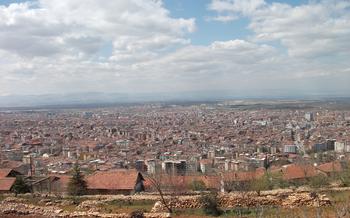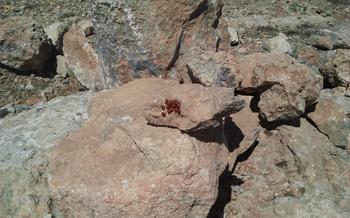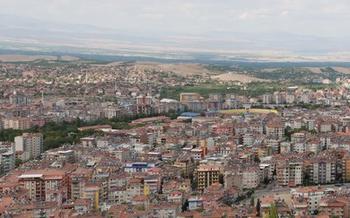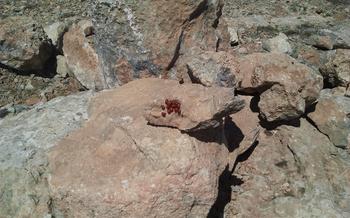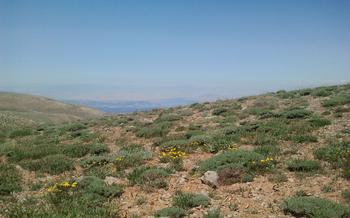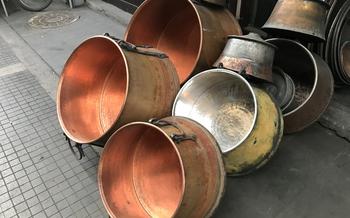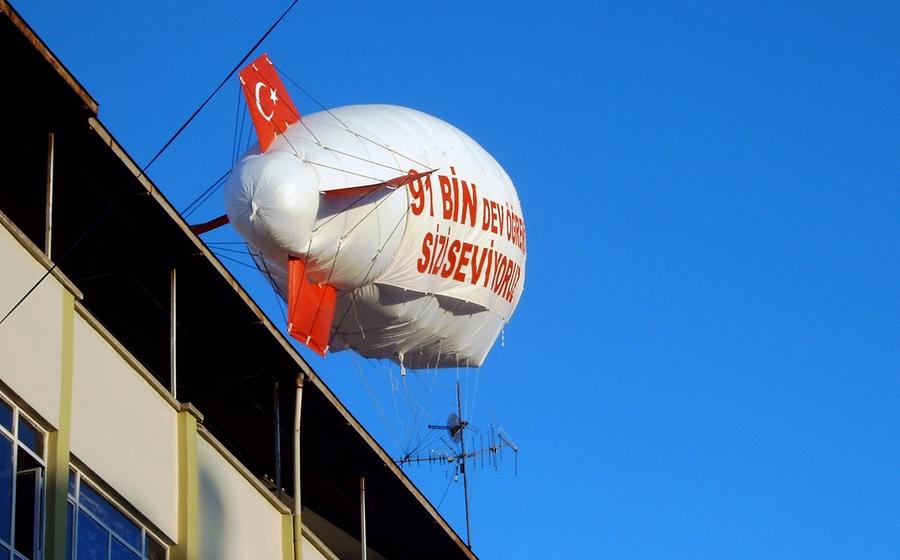
Pütürge Weeping Rock (Ağlayan Kayalar)
- Pütürge Weeping Rock: Unveiling Nature's Enigma
- Formation and Composition: Unraveling Nature's Masterpiece
- Cultural Significance: A Tapestry of Beliefs and Traditions
- Visitors' Experiences: Awe and Wonder in Every Drop
- Personal anecdotes
- Emotional impact
- Photographic opportunities
- Responsible tourism
- A Glimpse into History: The Weeping Rock Through the Ages
- Local Cuisine: A Culinary Adventure in Malatya
- Nearby Attractions: Exploring the Region's Hidden Gems
- Accommodation: Finding Your Home Away from Home
- Weather and Climate: Planning for the Perfect Visit
- Safety and Security: Ensuring a Worry-Free Experience
- Language and Communication: Bridging Cultural Gaps
- Budget and Costs: Planning Your Financial Journey
- Responsible Tourism: Treading Lightly on Nature's Canvas
- Insider Tip: Uncovering Hidden Gems
Pütürge Weeping Rock: Unveiling Nature's Enigma
Deep within the heart of Turkey's Malatya province lies a captivating natural wonder that has enthralled visitors for centuries – the Pütürge Weeping Rock. This remarkable geological formation, known locally as Ağlayan Kayalar or "Weeping Rocks," is a testament to the intricate interplay between science, history, and mysticism.
Geological Wonder:
The Pütürge Weeping Rock is a fascinating geological marvel, defying the laws of gravity as water seeps from its pores, creating a mesmerizing spectacle that resembles tears streaming down the rock's surface. This phenomenon is attributed to the unique composition of the rock, which contains a high concentration of calcium carbonate, allowing water to infiltrate its structure and seep through its pores.
Historical Significance:
Throughout history, the weeping rock has been a subject of local folklore and cultural beliefs. Legends abound, attributing the rock's tears to the sorrow of a young woman who was separated from her lover. Others believe the rock's weeping is a sign of divine intervention or a blessing from the heavens.
Mystical Allure:
The weeping rock is shrouded in an aura of mystery and superstition. Some believe that the water possesses healing properties, while others view it as a symbol of hope and good fortune. Visitors often make wishes or leave offerings at the base of the rock, seeking blessings or expressing gratitude for answered prayers.
Practical Information:
The Pütürge Weeping Rock is located approximately 10 kilometers from the city of Pütürge in Malatya province. It is easily accessible by car or public transportation. Visitors can explore the site at their leisure, marveling at the weeping rock's beauty and soaking in the tranquil atmosphere.
Formation and Composition: Unraveling Nature's Masterpiece
The Pütürge Weeping Rock is a geological marvel formed through a complex interplay of natural processes. The rock's unique ability to "weep" continuously stems from a combination of its composition and the surrounding environment.
The weeping rock is primarily composed of a porous limestone known as travertine. Travertine is formed by the deposition of calcium carbonate from water sources, often in the form of hot springs or groundwater. The Pütürge Weeping Rock is believed to have been formed by the precipitation of calcium carbonate from a nearby hot spring.
The water that seeps from the rock originates from underground aquifers that are recharged by rainwater and melting snow. As the water percolates through the porous travertine, it dissolves minerals and picks up dissolved calcium carbonate. When the water reaches the surface, it evaporates, leaving behind a thin layer of calcium carbonate on the rock's surface. This process, repeated over thousands of years, has resulted in the formation of the distinctive stalactites and stalagmites that adorn the weeping rock.
Environmental factors such as temperature and humidity also play a role in the weeping phenomenon. Higher temperatures and lower humidity levels increase the rate of evaporation, leading to more visible weeping. Conversely, cooler temperatures and higher humidity levels slow down the evaporation process, resulting in less visible weeping.
Cultural Significance: A Tapestry of Beliefs and Traditions
The Pütürge Weeping Rock holds immense cultural significance, deeply intertwined with the beliefs and traditions of the local community. According to local folklore, the rock is believed to be the embodiment of a young woman named Pütürge, who was turned into stone by a vengeful spell cast upon her by her stepmother. The tears that seep from the rock are said to symbolize her eternal sorrow and longing for her lost love.
In religious beliefs, the weeping rock is revered as a sacred site. Many locals believe that the water from the rock possesses healing powers and can cure various ailments. It is not uncommon to see people collecting the water in bottles to use for medicinal purposes. The rock also holds spiritual significance for some, who visit it to pray and seek blessings.
Traditional beliefs about the weeping rock are deeply rooted in the local culture. Some believe that the rock's tears are a sign of good luck and prosperity, while others see it as a warning of impending danger or misfortune. The rock is also associated with fertility and is often visited by couples who are hoping to conceive.
The weeping rock serves as a powerful symbol of local cultural identity and heritage. It is a source of pride for the people of Malatya and is often featured in local art, literature, and music. The site is also a popular destination for cultural events and festivals, attracting visitors from near and far.
Visitors' Experiences: Awe and Wonder in Every Drop
The Pütürge Weeping Rock is not just a natural phenomenon; it's an experience that touches the hearts and souls of visitors. The awe-inspiring sight of water seemingly defying gravity as it trickles down the rock face creates a sense of wonder and tranquility that is unmatched.
Personal anecdotes
I vividly recall my first encounter with the weeping rock. As I approached, I was struck by the sheer beauty of the cascading water, glistening in the sunlight. The rhythmic dripping sound created a soothing atmosphere, inviting me to pause and simply observe the spectacle before me.
Emotional impact
The weeping rock has a profound emotional impact on visitors. The sight of water emerging from solid rock evokes a sense of mystery and wonder, reminding us of nature's hidden powers. The gentle flow of water has a calming effect, inviting visitors to let go of their worries and simply be present in the moment.
Photographic opportunities
The weeping rock is a photographer's paradise. The contrast between the dark, rugged rock and the shimmering water droplets creates striking images. The constantly changing patterns of the water flow offer endless opportunities for capturing unique and mesmerizing shots. Remember to bring your camera and tripod to capture the beauty of this natural wonder.
Responsible tourism
It's important to remember that the weeping rock is a delicate natural formation. Visitors should be mindful of their impact on the environment and avoid touching or disturbing the rock. Please stay on designated paths and refrain from littering to preserve the natural integrity of the site for future generations.
A Glimpse into History: The Weeping Rock Through the Ages
The Pütürge Weeping Rock has captivated the imaginations of locals and visitors alike for centuries, leaving an indelible mark on the region's history and folklore. Ancient texts and records provide glimpses into the earliest known references to the weeping rock, hinting at its significance in shaping local beliefs and traditions. Over time, perceptions and beliefs about the rock have evolved, influenced by cultural, religious, and scientific developments. Notable scientific studies and research conducted on the weeping rock have shed light on its geological and hydrological processes, while conservation efforts have been undertaken to protect and preserve this natural wonder for future generations. Exploring the weeping rock's rich history offers a deeper appreciation of its cultural and scientific importance, providing a glimpse into the fascinating tapestry of human interaction with this enigmatic natural phenomenon.
Local Cuisine: A Culinary Adventure in Malatya
Malatya's cuisine is a harmonious blend of flavors and aromas, reflecting the region's rich cultural heritage. A culinary adventure awaits visitors, tempting their palates with must-try dishes that showcase the region's unique culinary identity.
- Regional Specialties:
- Kayısı Köftesi: Savor the delectable Kayısı Köftesi, a signature dish made from dried apricots, bulgur, and walnuts, offering a delightful balance of sweet and savory flavors.
-
Malatya Mantısı: Indulge in the local specialty, Malatya Mantısı, delicate dumplings filled with minced meat and yogurt sauce, a true testament to the region's culinary artistry.
-
Culinary Traditions:
- Kebabs: Experience the art of Turkish kebab in Malatya, where succulent grilled meats, seasoned to perfection, are a culinary delight not to be missed.
-
Meze: Explore the vibrant world of meze, an array of small plates featuring a variety of dips, salads, and appetizers, offering a tantalizing introduction to Turkish cuisine.
-
Recommended Restaurants:
- Tarihi Güzide Restaurant: Immerse yourself in the flavors of Malatya at Tarihi Güzide Restaurant, renowned for its authentic regional dishes and warm hospitality.
-
Özsüt: Delight in the culinary creations at Özsüt, a modern restaurant that fuses traditional flavors with contemporary culinary techniques, offering a unique dining experience.
-
Vegetarian Options:
- Şevket-i Bostan: Discover the delights of vegetarian cuisine at Şevket-i Bostan, where fresh, seasonal ingredients are transformed into mouthwatering dishes that cater to meat-free preferences.
- Narlıbahçe: Experience the vibrant flavors of Turkish vegetarian cuisine at Narlıbahçe, offering a diverse menu of dishes that celebrate the bounty of local produce.
Nearby Attractions: Exploring the Region's Hidden Gems
Malatya is not just home to the intriguing Pütürge Weeping Rock; it also boasts a plethora of hidden gems waiting to be explored. History buffs can delve into the region's rich past by visiting the Arslantepe Mound, an ancient settlement dating back to the 4th millennium BC, or the Malatya Museum, which houses a collection of artifacts from various civilizations that have graced this land.
Nature enthusiasts will be captivated by the breathtaking Darende Waterfall, a cascading wonder surrounded by lush greenery, or the Soğuksu National Park, a haven for hikers and nature lovers, offering stunning views and diverse flora and fauna.
For a unique cultural experience, visitors can immerse themselves in the traditional art of copper craftsmanship in the town of Arapgir, renowned for its exquisite copperware and intricate designs. The Malatya International Film Festival, held annually, showcases a diverse range of films from around the world, providing a platform for cultural exchange and appreciation.
Adventurous travelers can embark on a thrilling hot air balloon ride over the picturesque landscapes of Malatya, offering a bird's-eye view of the region's natural beauty. For those seeking a spiritual experience, the Battalgazi Tomb and Complex, a historical site associated with the legendary Turkish hero Battalgazi, offers a glimpse into the region's rich religious heritage.
Accommodation: Finding Your Home Away from Home
When planning your visit to Malatya, choosing the right accommodation is crucial to ensuring a comfortable and memorable stay. The city offers a diverse range of options to suit every traveler's needs and budget.
For those seeking a luxurious and convenient experience, several upscale hotels are located in the heart of the city, providing easy access to the weeping rock and other attractions. These hotels often feature modern amenities, spacious rooms, and attentive service, making them ideal for discerning travelers.
Budget-conscious travelers can find a variety of affordable options, including hostels, guesthouses, and smaller hotels. These accommodations offer basic yet comfortable rooms at a fraction of the cost of luxury hotels. Many of these budget-friendly options are centrally located, allowing guests to explore the city on foot or by public transportation.
For those seeking a unique and immersive experience, Malatya offers several charming boutique hotels and traditional guesthouses. These accommodations often showcase local architecture and design, providing guests with a glimpse into the city's rich cultural heritage. Some even offer traditional Turkish baths and other amenities to enhance your stay.
When booking your accommodation, it's advisable to consider factors such as location, amenities, and budget. Advance reservations are recommended, especially during peak tourist seasons, to secure your preferred choice. Online booking platforms and travel agents can assist you in finding the best deals and discounts.
Weather and Climate: Planning for the Perfect Visit
Malatya's climate is characterized by hot, dry summers and cold, snowy winters. The ideal time to visit the city is during the spring (April-May) or autumn (September-October) when the weather is pleasant and the weeping rock is at its most active. In the summer (June-August), temperatures can soar above 35°C, making it uncomfortable to explore the city. Winters (November-March) are cold, with temperatures dropping below freezing, and snow is common.
When packing for your trip, consider the season you're visiting in. In the summer, light, breathable clothing and sunscreen are essential. In the winter, pack warm layers, a hat, gloves, and sturdy footwear.
Before your trip, check the weather forecast to stay informed about current conditions. This will help you plan your activities and dress appropriately.
Safety and Security: Ensuring a Worry-Free Experience
Malatya is generally considered a safe city for travelers. However, as with any destination, it's essential to exercise common sense and take necessary precautions to ensure a worry-free experience. Here are some safety tips to keep in mind:
-
Be aware of your surroundings: Pay attention to your surroundings, especially when visiting crowded areas or exploring unfamiliar neighborhoods. Avoid walking alone at night, and stick to well-lit streets.
-
Avoid isolated areas: Deserted areas, especially at night, should be avoided. If you find yourself in an isolated area, stay alert and be prepared to leave quickly if necessary.
-
Respect local customs: Respecting local customs and traditions is essential for a positive experience in Malatya. Dress modestly, avoid public displays of affection, and be mindful of religious practices and beliefs.
-
Emergency contacts: Keep a list of emergency contact numbers handy, including the local police, hospital, and your embassy or consulate. In case of an emergency, dial 112 for assistance.
Language and Communication: Bridging Cultural Gaps
Venturing into a foreign land often brings about the challenge of language barriers. In Malatya, Turkish is the official language, and its prevalence is evident throughout the city. While English proficiency varies among locals, it's essential to be prepared for limited English communication.
To overcome language barriers, travelers can embrace the adventure and immerse themselves in the local culture. Translation apps can be handy, and hiring a guide is an excellent option for those seeking deeper insights into the region's history and traditions. Additionally, learning a few basic Turkish phrases can go a long way in showing respect for the local customs and fostering positive interactions.
Non-verbal communication plays a significant role in bridging cultural gaps. A smile, a nod, or a gesture can convey more than words, especially when combined with patience and understanding. Embracing non-verbal cues and being open to cultural differences can create meaningful connections and enhance the overall travel experience.
Budget and Costs: Planning Your Financial Journey
Venturing to Malatya allows travelers to immerse themselves in rich cultural experiences without breaking the bank. The estimated daily budget for a comfortable trip ranges from 50 to 100 euros, depending on your travel style and preferences.
Accommodation costs vary depending on the level of comfort and amenities desired. Budget-conscious travelers can find hostels or guesthouses starting at 15 euros per night, while mid-range hotels typically range from 25 to 50 euros per night. For a luxurious stay, expect to pay upwards of 100 euros per night for high-end hotels.
Food and dining offer a delightful blend of flavors and affordability. Local restaurants serve delicious Turkish cuisine at reasonable prices, with an average meal costing around 10 to 15 euros. For those seeking a taste of upscale dining, expect to pay approximately 20 to 30 euros for a memorable culinary experience.
Transportation costs are relatively low, with a single bus ticket costing around 1 euro. Renting a car is another option, with daily rates starting at 20 euros. Airport transfers typically range from 15 to 25 euros, depending on the distance and mode of transportation.
Additional expenses, such as souvenirs, activities, and unexpected costs, should also be factored into the budget. Allocate approximately 20 to 30 euros per day to cover these miscellaneous expenses, ensuring a well-rounded and enjoyable travel experience in Malatya.
Responsible Tourism: Treading Lightly on Nature's Canvas
As travelers, we have a responsibility to minimize our impact on the environment and support sustainable practices. When visiting natural wonders like the Pütürge Weeping Rock, it's crucial to adopt responsible tourism habits.
Respect the natural environment by avoiding littering, damaging plants, or disturbing wildlife. Embrace the concept of "leave no trace," ensuring you leave the site as pristine as you found it. Conserve water and energy during your stay, and opt for eco-friendly accommodation and transportation options whenever possible.
Support local businesses that prioritize sustainability. Choose restaurants that use locally sourced ingredients and support artisans who create eco-conscious products. By doing so, you contribute to the local economy while promoting responsible practices.
Respect local customs and traditions. Dress modestly, be mindful of noise levels, and seek permission before taking photographs of people or religious sites. Engage with locals respectfully, and be open to learning about their culture and way of life.
By practicing responsible tourism, we can ensure that future generations can continue to marvel at the beauty of natural wonders like the Pütürge Weeping Rock while preserving its delicate ecosystem.
Insider Tip: Uncovering Hidden Gems
Beyond the main attractions, Malatya offers a treasure trove of hidden gems waiting to be discovered by curious travelers. For those seeking unique perspectives, venture off the beaten path to uncover secret viewpoints that offer breathtaking panoramas of the weeping rock and its surroundings. These hidden vantage points provide a chance to capture stunning photographs and create lasting memories.
Enrich your experience by joining guided tours led by knowledgeable local experts who can share fascinating insights into the history, geology, and cultural significance of the weeping rock. These tours often include visits to lesser-known caves, waterfalls, and natural formations that are hidden from the average tourist.
For photography enthusiasts, the weeping rock presents a multitude of opportunities to capture its beauty. The constantly dripping water creates a mesmerizing effect, and the play of light and shadow on the rock's surface offers endless possibilities for creative shots. Experiment with different angles, compositions, and lighting conditions to capture the essence of this natural wonder.
If you're looking for a truly off-the-beaten-path experience, consider exploring the surrounding countryside and villages. Discover hidden gems such as traditional Turkish villages, ancient ruins, and local markets that provide a glimpse into the authentic culture and lifestyle of the region. Embrace the opportunity to interact with locals, sample delicious regional cuisine, and create memories that will last a lifetime.

